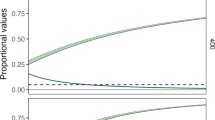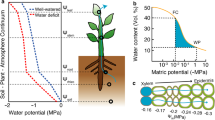Abstract
THE results of Weatherley and Slatyer1,2 show that, for a given loss of water, privet leaf disks develop a greater diffusion pressure deficit and suffer a greater fall in turgor pressure (down to zero) than tomato leaf disks. The greater diffusion pressure deficit is due mainly to the higher osmotic potentials recorded in privet2, as in woody plants in general3, but a second contributory factor indicated by the greater drop of turgor pressure is a greater mechanical resistance to shrinkage in privet, and this again seemed likely to be a general difference between woody and herbaceous plants. Some comparative observations on changes in volume during loss of water from detached leaves of woody and herbaceous plants have underlined the mechanical difference between them.
Similar content being viewed by others
References
Weatherley, P. E., and Slatyer, R. O., Nature, 179, 1085 (1957).
Slatyer, R. O., Austr. J. Biol. Sci., 10, 320 (1957).
Miller, E. C., “Plant Physiology” (McGraw-Hill, 1938).
Russell, E. J., “Soil Conditions and Plant Growth” (Longmans, 1950).
Kennedy, J. S., Ent. Exp. Appl., 1, 50 (1958).
Author information
Authors and Affiliations
Rights and permissions
About this article
Cite this article
KENNEDY, J., BOOTH, C. Water Relations of Leaves from Woody and Herbaceous Plants. Nature 181, 1271–1272 (1958). https://doi.org/10.1038/1811271a0
Issue Date:
DOI: https://doi.org/10.1038/1811271a0
- Springer Nature Limited





